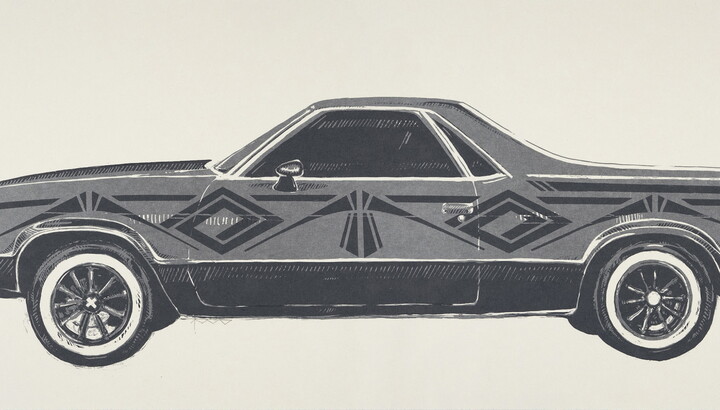The Carter Blog
Carter ARTicles
Travels with Georgia
May 10, 2023
With more than 55,000 objects in the Carter's art collection (of which nearly 50,000 are online), it is impossible to exhibit everything! Besides rotating what is on view in our galleries several times a year, we also loan artwork to other museums. This helps us meet our mission to serve all communities and advance scholarship. In our most recent fiscal year, the Carter loaned 99 artworks to museums around the country, and even the world!
For the next year, one of our visitor favorites, Red Cannas by Georgia O’Keeffe, is taking a trip and making stops in San Diego, Albuquerque, and Montréal before returning home to Fort Worth in fall 2024. We spoke with Marci Driggers, Head of Registration and Collections at the Carter, about what it takes to send Red Cannas on her way.
Who takes Red Cannas off the wall? Is it like taking a picture off the wall at home?
Not quite like doing it at home! We have a highly trained team of art preparators who physically remove artwork from the galleries. We have safety hardware that needs to be removed from the hooks on the back. The preparators wear gloves to protect the fragile frame surface, put it on a cart, and transport it into the vault.
What happens to it next?
The painting will stay in the vault until it’s time to pack it for travel. This gives the courier (the person who will accompany the painting on its journey) a chance to inspect the painting closely and do a thorough condition report. This is essentially a report that has an image of the painting where marks can be made showing pre-existing cracks, scratches or anything else that needs to be noted.
Who makes the crate?
We use several local art handling companies to build our crates. These crates are works of art in and of themselves! They are built specifically for the painting or whatever object is going in the crate. When we ship sculptures, for example, even more design work goes into the crate. Often, braces or brackets are also made to secure a 3-D object. Whenever possible, we will re-use existing crates by retrofitting the inside for a different painting.
How is it placed in the crate? Is it wrapped in something that protects it?
Very carefully! There are two general ways of packing a painting. Paintings with very ornate frames will often be attached to an inner crate with clips. This means that it travels on a mini ‘wall’ inside the crate. If the frame isn’t an issue, we can do a ‘pressure fit’, which means the crate has foam protection around all edges, and the painting is wrapped in either Dartek (a very thin nylon film) or plastic and then is pushed into the cavity. The lids also have foam blocks that help hold everything in place.
Will it fly to its destinations or travel in a truck?
In this case, Red Cannas will fly to San Diego. Most of the time we send our loans out on fine art shipping trucks. They are climate controlled, have air-ride suspension (to minimize vibrations), and live tracking. This trip will have some trucking on both the Texas and California ends, but at least there’s not a 20+ hour truck ride involved!
Will someone from the Carter travel with it?
Yes! Typically either a registrarjump to citation[x], a conservator, or preparator will travel with the art.
What happens to Red Cannas when it arrives at its destination?
The Carter registrar will accompany the painting all the way to the San Diego Museum of Art’s vault and watch them store it. The crate will remain unopened for at least 24 hours to let it, and the painting inside, acclimate to its new environment. The registrar will go back the following day to oversee the prep staff unpack the crate. She will do another condition report to make sure nothing changed during transit and watch them install it on the wall. Then, her work is done!
When will it return to the Carter?
Red Cannas will be part of the exhibition, O'Keeffe and Moore: From Bones and Stones to the Studio at the San Diego Museum of Art from May 13 to August 27, 2023. It then travels to the Albuquerque Museum from September 30 to December 31, 2023. The last venue is the Musée des beaux-arts de Montréal where it will be on view from February 5 to June 9, 2024. After that, it should return to our walls sometime in the fall of 2024.
For more about how art travels, read our Art on the road ARTicle from 2022.
Notes
- ↵ What is a registrar? The quickest way to describe a registrar is to say they are kind of like art babysitters. They need to know every detail about each work. They know where each object is (as in, its physical location at the Carter), what condition it’s in, how to properly ship it, insure it, and how to pack work when it travels. Registrars keep detailed records of the life of each object as well: how long we have had it in our collection, how it came to be in our collection (for example, did we purchase it, or was it gifted by a donor?), how many times it has traveled, and where, etc. They work with curators to bring their ideas to reality. When curators plan an exhibition, registrars are the ones that handle all of the logistics of getting multiple works to our Museum safely.








